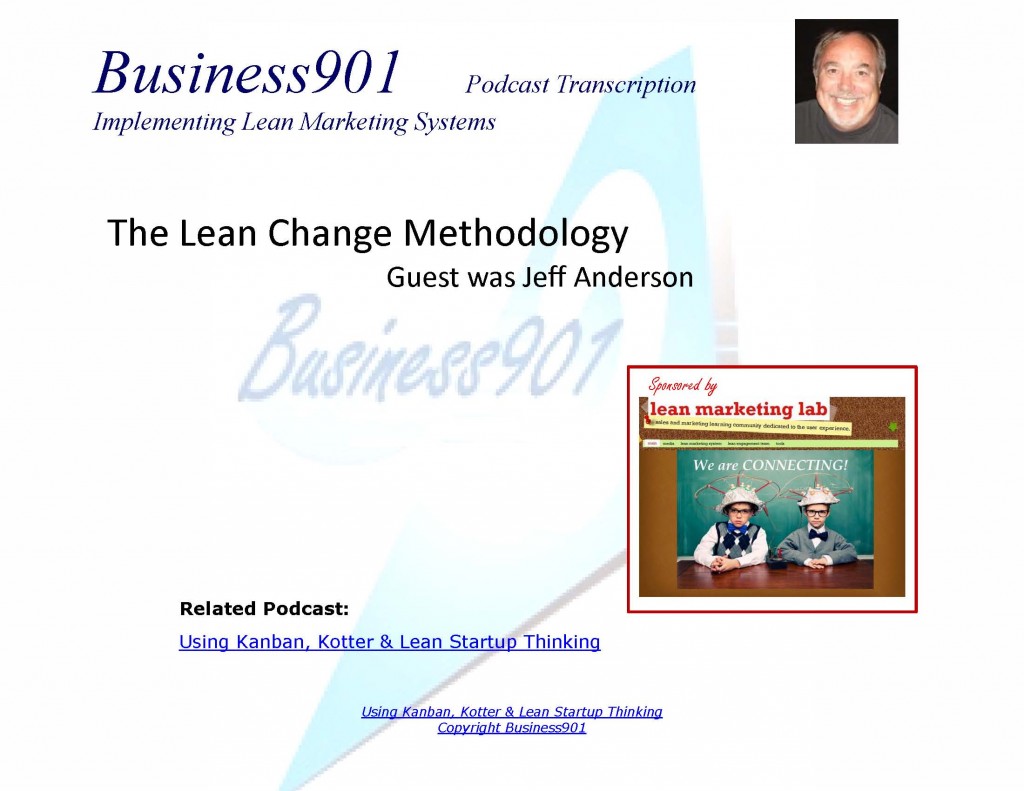In the podcast with Jeff Anderson, the catalyst behind the Lean Change Method, we discussed the Lean Change Techniques he has deployed at Deloitte. More information is available about the Lean Change Method at http://agileconsulting.blogspot.com/. Jeff leads the Deloitte Lean market offering, providing advisory, transformation, and change management services to software technology based organizations, helping them transform through the use of agile and lean methods.
Related Podcast: Using Kanban, Kotter & Lean Startup Thinking
Complete Transcription and PDF Download
Transcription Excerpt:
Joe Dager: What was the motivation for putting together the Lean Change method?
Jeff Anderson: Thanks a lot Joe. Let me just provide a little bit of context- you’ve done an excellent job in describing what I do for a living. Over the last several years, I’ve been trying to help fairly conservative IT organizations, as well as conservative technology/software product organizations transform from traditional methods; command and control, highly specialized organizations, waterfall delivery to using more Agile methods, and using more Lean thinking. This is actually pretty complex and pretty hard thing to do. I think most Agile change agents out there will agree with me that too many Agile transformations are still unsuccessful; we’ve got some great value out of Agile, and a lot of organizations have received good benefits from using Agile and Lean thinking, but it’s still a really hard thing to do. It’s still really complex.
You look out there, and the existing methods and tools used to conduct organizational transformations don’t actually lend themselves to the unpredictability of any type of organizational transformation; much less an organizational transformation trying to get an organization from traditional methods to new, modern and innovative techniques. Probably the most common method out there, unfortunately, is what I call the ‘Big C Consulting’ approach, where a whole lot of consults get hired by the executives within an organization. They spend a little bit of time analyzing the current state of that organization, and then they go, and they forklift one of the dozens of traditional models they’ve got in their catalogue of tool kits, put out an implementation road map, and watch as the change goes completely off the rails because of resistance, because of existing organizational cultural problems, because the change is just plain wrong.
On the other end, a lot of Agile transformations start with implementing some kind of Agile improvement technique “Scrum or Kanban” being an example. In this case what we end up doing is we try to find a place in the organization where we can adopt one or more of these improvement methods, try to adapt the context and hope things go well. In some cases, they go well, but in a lot of cases they still don’t, and we don’t actually know why. A lot of people say, “Scrum doesn’t match particular the context of a particular organization” and other people can say “Kanban just takes too long to be successful”. What my opinion is that if Agile transformation is going to happen in a reasonable time frame, it does require managed change. The change needs to be managed by the executives of the organization, by the managers of the organization, and it does require assistance sometimes from external consultants who have who have a lot of experiences in Agile and Lean, but we want to have managed change method that doesn’t lock us in an up-front plan, and into an up-front design.
I also wanted to make sure that I had a managed change method that wouldn’t disrespect the people being change. I wanted to make sure that what I call ‘change recipients’ of a change, which are the people that are actually being asked to do new things, I want to make sure my method enabled those people to be co-owners and co-creators of the change. So in a nut shell, the reason I made the “Lean Change Method” is I wanted a set of pragmatic tools for Agile change agents to be able to manage an Agile or Lean transformation in a way that would enable learning, quick changes in direction, and actually empower the change recipients to be co-creators and co-owners of that change.
Related Podcast: Using Kanban, Kotter & Lean Startup Thinking
Complete Transcription and PDF Download
Lean Engagement Team (More Info): The ability to share and create knowledge with your customer is the strongest marketing tool possible.
Lean Sales and Marketing: Learn about using CAP-Do


Comments are closed.